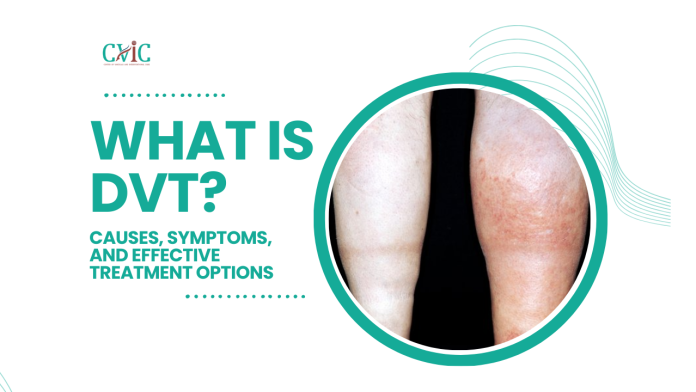Deep Vein Thrombosis (DVT) is a serious medical condition that occurs when a blood clot forms in a deep vein, most commonly in the legs. While it may seem like a simple circulation issue, untreated DVT can lead to life-threatening complications such as pulmonary embolism (PE)—a clot traveling to the lungs.
The World Health Organization (WHO) estimates that 1 in 1,000 people develop DVT each year, making it a significant health concern worldwide.
In this comprehensive guide, we’ll cover:
- What DVT is and how it forms
- Causes and risk factors
- Common symptoms and warning signs
- Diagnosis and medical evaluation
- Treatment options available today
- Prevention strategies for at-risk individuals
- Why CVIC Indore is a trusted center for DVT treatment
What is Deep Vein Thrombosis (DVT)?
DVT is the formation of a blood clot (thrombus) in a deep vein, usually in the legs or pelvis. Unlike superficial veins (close to the skin), deep veins are responsible for returning the majority of blood back to the heart.
When a clot forms here, it can partially or completely block blood flow, causing pain, swelling, and serious complications.
Causes of DVT
A combination of factors, known as Virchow’s Triad, contributes to DVT formation:
- Venous Stasis (Slow Blood Flow)
- Long periods of sitting or bed rest
- Travel (flights, long drives)
- Paralysis or immobility
- Endothelial Injury (Vein Wall Damage)
- Trauma or surgery
- Catheter placement
- Varicose veins or vascular injury
- Hypercoagulability (Blood Clotting Tendency)
- Genetic conditions (e.g., Factor V Leiden mutation)
- Cancer
- Pregnancy
- Hormone therapy or oral contraceptives
Risk Factors for DVT
- Age (over 60, but can occur at any age)
- Family history of blood clots
- Obesity
- Smoking
- Cancer treatments
- Prolonged hospitalization or surgeries
- Certain chronic diseases (heart disease, IBD, kidney disorders)
Symptoms of DVT
Some patients show no symptoms at all, but typical signs include:
- Swelling in one leg (rarely both)
- Pain or cramping in calf/thigh (especially when walking)
- Warmth in the affected leg
- Skin discoloration (reddish or bluish tint)
- Bulging superficial veins
⚠️ Warning: If a clot breaks off and travels to the lungs (Pulmonary Embolism), symptoms include:
- Sudden shortness of breath
- Chest pain
- Coughing up blood
- Rapid heartbeat
This is a medical emergency.
How is DVT Diagnosed?
Doctors use a combination of clinical evaluation and imaging:
- D-Dimer Blood Test – Detects clotting activity.
- Ultrasound (Doppler scan) – The gold standard for DVT detection.
- Venography – Contrast dye X-ray (rarely used now).
- MRI/CT Scans – In complicated cases or pelvic DVT.
Treatment Options for DVT
The primary goals are to:
- Stop clot growth
- Prevent clot migration to lungs (PE)
- Reduce long-term complications
1. Medications
- Anticoagulants (Blood Thinners): Heparin, Warfarin, Rivaroxaban, Apixaban.
- Thrombolytics (Clot-Busting Drugs): Used in severe cases, delivered directly into the clot.
2. Minimally Invasive Procedures
At advanced centers like CVIC Indore, interventional radiologists may perform:
- Catheter-Directed Thrombolysis (CDT): Catheter delivers clot-dissolving medicine directly into clot.
- Mechanical Thrombectomy: Devices physically break and remove the clot.
- IVC Filter Placement: Prevents clots from traveling to the lungs (used when blood thinners are not possible).
3. Supportive Therapies
- Compression Stockings to reduce swelling and prevent post-thrombotic syndrome.
- Lifestyle Modifications: Hydration, movement, smoking cessation, and weight control.
Complications of Untreated DVT
- Pulmonary Embolism (PE): A life-threatening emergency.
- Post-Thrombotic Syndrome (PTS): Chronic leg pain, swelling, ulcers due to vein damage.
- Recurrent DVT: Increased risk of future clots.
Prevention of DVT
- Stay active—avoid sitting for more than 2 hours at a stretch.
- Wear compression stockings on long flights/travel.
- Stay hydrated.
- Quit smoking.
- Follow doctor’s advice on anticoagulants after surgery.
DVT Treatment at CVIC Indore
At the Center of Vascular and Interventional Care (CVIC), Indore, we specialize in advanced DVT management using minimally invasive techniques.
Why Choose CVIC for DVT Care?
✅ Team of expert interventional radiologists
✅ Advanced ultrasound & catheter-based therapies
✅ Daycare procedures with minimal downtime
✅ Personalized care plans (medication + intervention + follow-up)
✅ Focus on both life-saving treatment and long-term vein health
📍 Location: CVIC – Center of Vascular and Interventional Care, Indore
📞 Contact: +91-8103727728
🌐 Website: https://cvicvascular.com/
FAQs About DVT
Q1. Can DVT go away on its own?
👉 Small clots sometimes dissolve, but untreated DVT is dangerous and can lead to pulmonary embolism.
Q2. How long does DVT treatment take?
👉 Blood thinners are usually prescribed for 3–6 months, while minimally invasive procedures provide immediate relief.
Q3. Can DVT come back after treatment?
👉 Yes, especially if risk factors persist. Prevention and follow-up at CVIC reduce recurrence.
Q4. Can exercise help prevent DVT?
👉 Yes, light exercise like walking improves circulation and lowers risk.
Q5. Is hospitalization required for DVT?
👉 Not always. With modern treatments at CVIC, many patients are treated on an outpatient basis.
Conclusion
DVT is a serious but treatable condition. Recognizing the symptoms early and seeking prompt medical care can prevent life-threatening complications like pulmonary embolism.
Thanks to modern treatments such as catheter-directed thrombolysis, thrombectomy, and advanced anticoagulants, patients can recover quickly and reduce future risks.
👉 If you suspect DVT or have a family history of vein disease, consult the experts at CVIC Indore for advanced, minimally invasive treatment and long-term vascular care.




